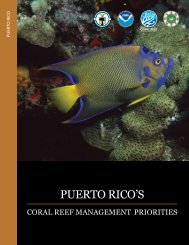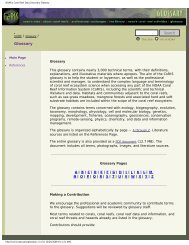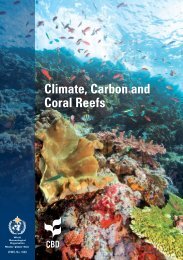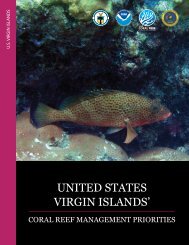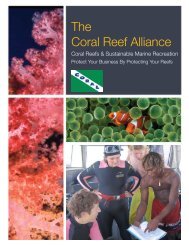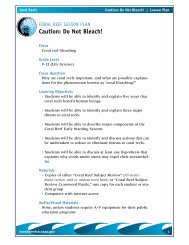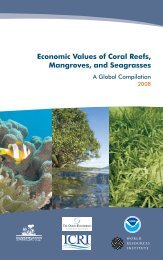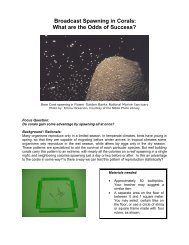Deep-Sea Coral Collection Protocols - NOAA's Coral Reef ...
Deep-Sea Coral Collection Protocols - NOAA's Coral Reef ...
Deep-Sea Coral Collection Protocols - NOAA's Coral Reef ...
- No tags were found...
You also want an ePaper? Increase the reach of your titles
YUMPU automatically turns print PDFs into web optimized ePapers that Google loves.
Specimen deterioration. We have seen that specimens in the different coral families deteriorate at verydifferent rates. Bamboo corals often break down very quickly and are handled first, followed byplexaurids such as Paramuricea sp. and its close relatives. Chrysogorgiids last for a moderately longtime (although many polyps die extended and often with tentacles extended as well) as do Paragorgiaand its relatives. Deterioration of bamboo corals can be seen in the tendency for the polyps to begin toslough off the axial skeleton. In Paramuricea and relatives, the tentacles begin to turn black withinabout 20 minutes of being put into the buckets.Fixation. There has been a lot of discussion on various lists about using formalin, especially withrespect to deterioration of sclerites. While there are many drawbacks and health issues associated withthis fixative, there are many benefits, the most important of which is the ease with which delicate tissuescan be rapidly fixed. Fortunately bamboo corals have easily-penetratable tissues, which may also bewhy they deteriorate so rapidly, even when handled with the best of procedures. As a result we haveadopted the following quick fixation procedure to be used for all octocorals with especially delicatetissues, such as the bamboo corals and chrysogorgiids. One or two buckets of 4% formalin-seawaterare prepared and stored capped in a fume hood. After the specimen has been tagged with its uniqueidentifier, it is put into the formalin bucket for about 12 hours. Following the formalin immersion it isrinsed in another bucket containing seawater and then transferred to a bucket or bag of 70% ethanol.The result is specimens that will be useful for taxonomic studies for a long time. We’ve seen that theseformalin fixed specimens show little contraction of the calyx and the relationship of the sclerites to thecoenenchyme is preserved, at least macroscopically.Other data collection. Fixation issues aside, once the specimens are safely stored in the cold room,each specimen goes through the following procedure before being finally stored for later use. The orderin which the first three of these items actually occur depends largely on the family of coral being dealtwith, the length of time since collection, and etc.1. Labeling. Each specimen is labeled by writing its identifier, collection date, and tentativename, onto a water-proof heavy paper which is tied to the specimen with monofilament line.2. Genetic sampling. Before the specimen is handled by too many pairs of hands (all equippedwith suitable gloves), pieces are set aside for genetic analysis. Usually we try to have a smallice-filled tray in the lab into which can be set plastic dishes (such as sandwich containersavailable from any supermarket) containing cold seawater. The genetic samples can be stored inthese small dishes until they can be dealt with.3. Photography. The entire specimen with its label and a ruler for scale is photographed,usually on a black cloth, but we have also used a gridded board. Close-up photos of specialfeatures or associates are also taken. We use a 5-megapixel camera with close-up capability.Several pictures are taken to be sure that at least one could be used for publication of themorphological description of the species.21





